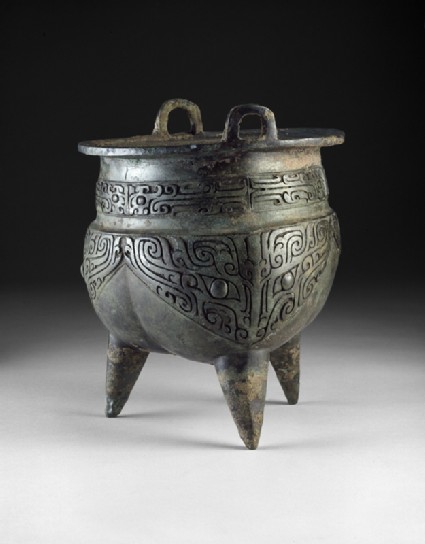Browse: 2530 objects
- Reference URL
Actions
Ritual food vessel, or li ding, with taotie masks
-
Description
Bronze ritual vessels were probably first manufactured in China during the early part of the Shang Dynasty (1600 BC–1050 BC), and this continued, with various changes in shapes and decoration until the end of the Eastern Zhou period in the third century BC. The earliest bronzes were decorated with narrow horizontal bands, with swirling ornamental lines centred on a pair of prominent eyes. These abstract patterns were developed during the Shang Dynasty and Western Zhou period (1050BC-771BC) to become more complex animal-like designs. The eyes provide a focus around which a more or less easily recognisable animal face gradually forms. This symmetrical mask, known as a taotie, and a related mythical beast called a kuei dragon are the predominant decorative themes on Shang bronzes.
This li-ding depicts an almost fully-formed taotie, repeated once above each of the three legs. The eyes are clearly outlined and two C-shaped horns, a snout and an upper jaw can be distinguished among the decorative curls. The highly stylised body of the animal extends to either side of the eyes and ends in a curled tail. This taotie, like many other examples from this period, may also be interpreted as two confronted kuei dragons, joined at a central, vertical line. The combination of two kuei reappears in the band around the top of the vessel, although here the various elements of the face and body are less clearly defined.
-
Details
- Associated place
- Material and technique
- bronze
- Dimensions
-
19.7 cm (height)
12 cm (diameter)
- Material index
-
processed material › metal › alloy › copper alloy › bronze
- Technique index
- Object type index
- No. of items
- 1
- Credit line
- Presented by Sir Herbert Ingram, 1956.
- Accession no.
- EA1956.855
-
Further reading
Loveday, Helen, Chinese Bronzes in the Ashmolean Museum: An Illustrated Handbook to the Collections (Oxford: Ashmolean Museum, 1990), p. 16, illus. p. 14 pl. 1
Bagley, Robert W., Shang Ritual Bronzes in the Arthur M. Sackler Collections, Ancient Chinese Bronzes in the Arthur M. Sackler Collections, 1 (Washington, D.C. : Arthur M. Sackler Foundation, 1987), p. 84, fig. 65
Piper, David, and Christopher White, Treasures of the Ashmolean Museum: An Illustrated Souvenir of the Collections, revised edn (Oxford: Ashmolean Museum, 1995), no. 11 on p. 16, illus. p. 17 fig. 11
Oxford: Ashmolean Museum, 24 May 2006-23 December 2008, Treasures: Antiquities, Eastern Art, Coins, and Casts: Exhibition Guide, Rune Frederiksen, ed. (Oxford: Ashmolean Museum, 2006), no. 168 on p. 60, illus. p. 60
Tregear, Mary, Chinese Art, World of Art Library (London: Thames and Hudson, 1980), fig. 12, p. 26
Glossary (2)
ding, taotie
-
ding
A Chinese bronze tripod ritual cooking vessel. Also a type of white porcelain from Northern China.
-
taotie
Stylized monster mask decoration with prominent eyes and scrolling horns. The motif has been known since the 1100s. Its significance remains mysterious.
Location
Objects are sometimes moved to a different location. Our object location data is usually updated on a monthly basis. Contact the Jameel Study Centre if you are planning to visit the museum to see a particular object on display, or would like to arrange an appointment to see an object in our reserve collections.
Galleries
© 2013 University of Oxford - Ashmolean Museum



